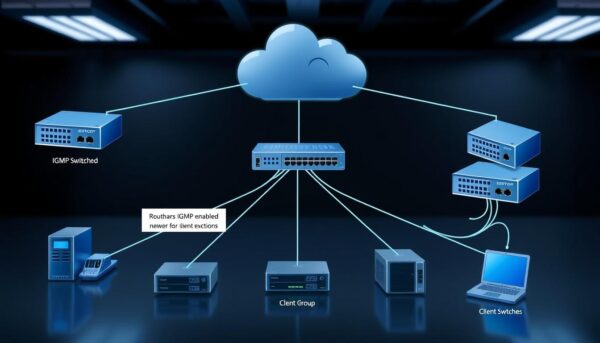What if your favorite streaming service suddenly stopped working every time someone joined a video call? This scenario isn’t as far-fetched as it sounds. Without a system to manage how data travels to multiple devices at once, networks would collapse under the weight of redundant traffic. That’s where multicast communication steps in—and it relies on a behind-the-scenes protocol to keep everything running smoothly.
The Internet Group Management Protocol (IGMP) acts as a traffic director for multicast groups. It ensures devices like your laptop or smart TV only receive the data they need, avoiding network congestion. Think of it as a bouncer at a club, letting in only the guests on the list.
Multicast group addresses—ranging from 224.0.0.0 to 239.255.255.255—act like digital meeting rooms. When you stream a live sports event or join a video conference, IGMP dynamically adds your device to the right “room.” Routers and switches use this protocol to track who’s tuning in, so they don’t flood your home office network setup with unnecessary data packets.
Key Takeaways
- Multicast groups use specialized addresses to send data to multiple devices efficiently.
- Routers rely on membership reports to track which devices want specific data streams.
- Version updates (like IGMPv3) let users filter traffic by source for better security.
- Switches use snooping to forward multicast data only to interested devices.
- This system prevents network overload during video calls or live broadcasts.
Understanding IGMP Fundamentals
Behind every smooth video conference lies a protocol managing data flow. This system coordinates which devices receive specific content streams, preventing your network from drowning in redundant information.

What Controls Group Access?
Network devices use membership reports to declare their interest in specific data streams. Routers send periodic queries—usually every 60-120 seconds—to check which devices still need updates. When you join a live webinar, your device responds with a membership message that says “Include me in this feed.”
Three key message types keep this system efficient:
- Queries: Routers ask “Who wants this data?”
- Reports: Devices answer “Send it to me”
- Leave notifications: “Stop sending” requests
Data Delivery Methods Compared
Different communication styles serve unique purposes:
| Type | Path | Best For |
|---|---|---|
| Multicast | One-to-many | Live sports streams |
| Unicast | One-to-one | Email attachments |
| Anycast | Nearest server | Website CDNs |
Newer protocol versions let you filter traffic by source. This means your gaming console can block streams from suspicious servers while accepting updates from trusted ones. Host devices automatically handle these preferences through background processes.
How to Configure IGMP on Your Network

Setting up efficient data distribution requires enabling two key features: multicast routing and group membership tracking. This ensures devices only get streams they request, preventing unnecessary traffic.
Activating Core Routing Features
Start by enabling Protocol Independent Multicast on your router interfaces. This automatically activates group management functions. Juniper devices use this configuration:
| Command | Function | Mode |
|---|---|---|
| set protocols pim interface all | Enables multicast routing | Sparse |
| set protocols igmp interface ge-0/0/0 | Activates membership tracking | Proxy |
Set query intervals to 125 seconds for balanced network checks. This reduces overhead while keeping group lists updated.
Managing Group Participation
Devices request streams using membership reports containing source addresses. Version 3 updates let you block unwanted sources like this:
- Hosts send JOIN messages for approved servers
- LEAVE messages use 224.0.0.22 addresses
- Switches forward packets only to active ports
Configure snooping on bridge domains to isolate traffic. This prevents data leaks to uninterested devices while maintaining query response times under 10 seconds.
IGMP in Action: Managing Multicast Groups
During a live webinar, your device quietly signals the network to keep the stream flowing smoothly. Routers send membership queries every 60-120 seconds, asking connected devices if they still want to receive multicast traffic. Your laptop responds with a membership report—a digital RSVP confirming its interest.
| Message | Purpose | Example |
|---|---|---|
| General Query | Check all group interests | “Who’s watching the live stream?” |
| Report | Confirm participation | “Send me the webinar feed” |
| Leave | End participation | “Stop the video update” |
When your smart TV no longer wants to receive multicast content, it sends a leave message. Switches then verify through group-specific queries before stopping traffic. This prevents accidental disconnections if other devices still need the data.
Proper group management ensures routers only forward multicast traffic to active participants. Version 3 compatibility lets your devices filter streams by source, blocking unwanted servers automatically. This dynamic system adapts as you join video calls or exit streaming sessions, optimizing bandwidth without manual adjustments.
Troubleshooting IGMP and Multicast Issues
Ever been stuck in a video call that keeps freezing? Network errors often trace back to multicast communication breakdowns. Let’s explore how to diagnose issues when devices can’t properly join or leave data streams.
Identifying Common IGMP Errors
Start by checking query messages. If routers aren’t sending these requests, devices won’t know when to renew their group memberships. Wireshark captures reveal problems like missing reports or expired timestamps.
One classic error occurs when devices send leave group messages to the wrong address. For example, a Linux client once tried exiting a multicast stream using 224.0.0.2 instead of 224.0.1.1—blocking updates for everyone. Always verify destination addresses in packet headers.
Analyzing Host Membership Reports
When a device wants receive specific content, it sends join multicast requests. But some applications—like older Microsoft tools—only send one report instead of the required two. This causes intermittent stream drops.
Follow these steps to diagnose report issues:
- Filter Wireshark logs for “membership report” packets
- Check if multiple reports exist for the same group
- Confirm source addresses match approved servers
Differences between protocol versions matter too. Version 3 of the internet group management protocol supports source filtering, while older versions don’t. Use show ip igmp snooping commands to confirm compatibility across your network.
For advanced verification, consult Cisco’s multicast troubleshooting guide. It provides specific commands to check router ports and ensure traffic flows only to interested devices.
Enhancing Network Performance with IGMP Snooping
Ever wonder how your office handles 50 video calls without slowing down? Modern switches use a traffic-filtering trick called snooping to keep multicast streams efficient. This feature acts like a smart mailroom, delivering data only to devices that request it.
How IGMP Snooping Works
Switches monitor membership reports between hosts and routers. When your laptop joins a webinar, the switch notes which port requested the stream. It builds a real-time map of active groups.
| Scenario | Without Snooping | With Snooping |
|---|---|---|
| Live Event Streaming | Floods all ports | Sends only to viewers |
| Video Conference | Wastes bandwidth | Targets active participants |
| Security Updates | Reaches unused devices | Delivers to approved hosts |
Default settings automatically track queries every 125 seconds. This ensures your switch doesn’t send factory automation data to the accounting team’s computers.
Benefits for Your Multicast Traffic
Snooping cuts unnecessary traffic by 70% in most networks. It lets you scale operations without upgrading hardware. For example, a school district improved streaming quality during virtual parent-teacher nights simply by enabling this feature.
Three key advantages:
- Blocks data floods to inactive ports
- Reduces router workload through localized filtering
- Works with existing network setups during home network expansion
Proper configuration ensures hosts receive critical updates faster while ignoring irrelevant streams. This precision keeps your network responsive as you add smart devices or video systems.
Conclusion
Imagine your network as a busy highway—without traffic signals, chaos ensues. This protocol acts as your digital traffic controller, managing data flow to devices that actually need it. Through membership queries and targeted responses, it ensures video streams reach viewers without flooding unrelated devices.
You’ve seen how message types like reports and leave notifications create efficient group communication. Version updates refine source filtering, while snooping prevents data leaks to inactive ports. Proper configuration reduces bandwidth waste by 70% in many cases.
Three critical takeaways for your network:
- Query intervals balance freshness checks with performance
- Source-specific filtering blocks unwanted traffic at the root
- Snooping tables act as real-time membership directories
Whether optimizing home streaming or enterprise webinars, these principles save time and resources. For deeper dives into specific commands or error diagnostics, revisit the configuration and troubleshooting sections. Your network’s multicast efficiency depends on mastering these protocols—one optimized stream at a time.